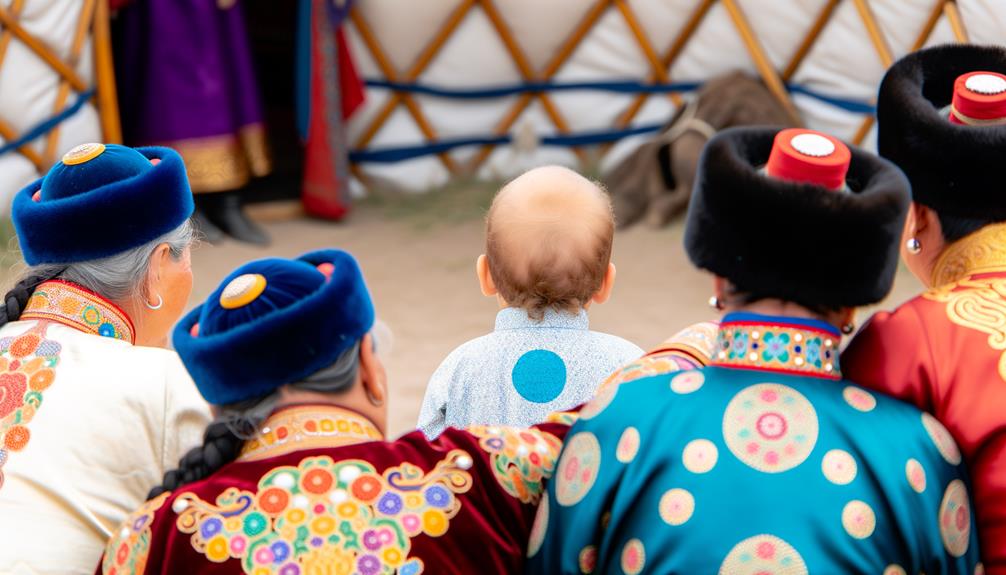Mongolian Blue Spot Spiritual Meaning: Ancestral Protection
The Mongolian Blue Spot isn’t just a physical mark; it’s steeped in spiritual meaning. You may find it seen as a sacred link to ancestry and a symbol of protection across various cultures in East Asia, Central Asia, and parts of Africa.
Many believe it guards against evil spirits and ties individuals to their heritage, fostering a sense of identity and community. In Mongolian culture, it symbolizes resilience, innocence, and spiritual guidance from ancestors.
So, if you’re curious about the deeper cultural and spiritual dimensions of this unique mark, there’s much more to explore.

Mongolian Blue Spot Spiritual Meaning: Ancestral Protection and Spiritual Markings
| Aspect | Spiritual Meaning |
|---|---|
| Origin | Birthmark typically found on infants, especially in Asian, African, and Indigenous roots |
| Symbolism | Ancestral blessing, spiritual protection, karmic imprint |
| Cultural Beliefs | Sign of divine heritage or past life connection |
| Spiritual Significance | Seen as a reminder of soul journey, reincarnation, and spiritual contract |
| Fade Over Time | Symbolizes spiritual evolution as the soul matures in the physical world |
Cultural Significance

The Mongolian Blue Spot holds deep cultural significance in many societies, often being regarded as a mark of heritage and identity.
You’ll find that in various communities, this birthmark is more than just a physical characteristic.
It’s frequently seen as a connection to one’s ancestry and ethnic roots.
In regions like East Asia, Central Asia, and parts of Africa, the presence of the Mongolian Blue Spot can be a source of pride.
It denotes a shared lineage and cultural history that binds people together through generations.
Symbol of Protection
You’ll find that the Mongolian Blue Spot is often viewed as a symbol of protection in many cultures. Traditionally, it’s believed to ward off evil spirits, ensuring safety for the newborn.
In addition, the mark signifies a deep ancestral connection, linking the child to their lineage and spiritual heritage.
Ward Off Evil Spirits
In many Mongolian cultures, the blue spot is believed to protect children by warding off evil spirits. This notion stems from deep-rooted spiritual beliefs and cultural practices that view the spot as a powerful shield.
Observing these beliefs, you’ll find that the blue spot symbolizes:
- Protection: It’s thought to guard children from malevolent forces.
- Strength: The spot is seen as a mark of resilience and liveliness.
- Purity: Associated with innocence, it guarantees the child’s soul remains untainted.
- Connection: It links the child to their cultural heritage and collective community spirit.
These elements showcase an intricate tapestry of beliefs where the blue spot serves as a significant emblem of safeguarding and spiritual fortification.
Ancestral Connection Significance
Many Mongolian traditions regard the blue spot as a profound link to ancestral spirits, symbolizing a protective bond that transcends generations.
You’ll find that this birthmark, often appearing at the base of a child’s spine, is seen as a mark bestowed by ancestors. It’s believed that these spirits offer guidance and protection throughout the individual’s life.
The blue spot serves as a reminder of one’s roots and cultural heritage, instilling a sense of belonging and continuity.
Ethnographic studies highlight how families in Mongolia perform rituals to honor these ancestral connections, reinforcing the spiritual significance of the spot.
This practice underscores a broader cultural understanding of interconnectedness, where the past and present coexist harmoniously, offering comfort and security.
Ancestral Connection

When you consider the Mongolian Blue Spot, its significance goes beyond mere physical appearance, tying directly into heritage and lineage.
Cultures across the globe view these marks as a sign of ancestral guidance, connecting individuals to their spiritual roots.
This belief underscores the spot’s role in maintaining a link between generations, fostering a profound sense of identity and belonging.
Heritage and Lineage Significance
The Mongolian Blue Spot often serves as a physical manifestation of one’s deep ancestral roots, reflecting a profound connection to heritage and lineage. This birthmark, prevalent in various indigenous communities, carries significant cultural weight. By understanding its role, you can appreciate the tangible link to your ancestry.
Ethnographic studies reveal that the spot symbolizes:
- Cultural Identity: It marks you as part of a distinct ethnic group.
- Historical Continuity: It connects you to a lineage that spans generations.
- Community Belonging: It signifies your place within a broader social network.
- Ancestral Honor: It acts as a tribute to your forebears’ lives and struggles.
Recognizing these aspects fosters a deeper appreciation for your own heritage and the enduring legacy of your ancestors.
Spiritual Ancestral Guidance
In the context of spiritual ancestral guidance, the Mongolian Blue Spot is often seen as a conduit through which ancestral wisdom and protection flow into your life. This birthmark is believed to be a physical manifestation of your connection to your forebears, serving as a reminder of their enduring presence.
Ethnographic studies reveal that many cultures interpret the blue spot as a sign that your ancestors are watching over you, offering guidance and support. This belief underscores the importance of honoring your heritage and maintaining a spiritual connection with those who came before you.
Understanding this cultural perspective can deepen your appreciation for the Mongolian Blue Spot’s role in your spiritual journey and ancestral lineage.
Spiritual Journey
On a spiritual journey, the Mongolian blue spot often symbolizes ancestral connections and protective energies in various cultures. This mark, seen on infants, acts as a tangible link to the past, grounding you in your heritage. It’s believed that the spot serves as a spiritual talisman, safeguarding the child through early life.
Consider these points to understand its significance deeply:
- Cultural Heritage: It ties you to your ancestors, reminding you of your roots.
- Protection: Viewed as a shield, it wards off harmful spirits.
- Identity: It reinforces your belonging to a specific lineage and community.
- Guidance: It’s seen as a sign that ancestral spirits are watching over you.
These elements highlight the rich, protective symbolism of the Mongolian blue spot on your spiritual journey.
Mythological Interpretations

Across various mythologies, the Mongolian blue spot is often portrayed as a mystical mark bestowed by divine forces. You’ll find these interpretations enriching, as they reveal cultural nuances and beliefs. In some Asian traditions, it’s seen as a mark of protection, a divine safeguard against malevolent spirits. Native American lore often views it as a sign of ancestral blessing, linking the newborn to their heritage.
Here’s a quick overview:
| Mythology | Interpretation | Cultural Significance |
|---|---|---|
| Asian | Divine protection | Safeguard against evil spirits |
| Native American | Ancestral blessing | Connection to heritage |
| African | Symbol of spiritual journey | Pathway to wisdom |
| European | Mark of fairy intervention | Enchantment and good fortune |
These mythological interpretations show how the Mongolian blue spot connects individuals to their cultural and spiritual identities.
Modern Beliefs
Today, the Mongolian blue spot often sparks curiosity and varied interpretations within modern spiritual and cultural contexts. You might find that these beliefs are shaped by a blend of tradition and contemporary thought.
Many people see the blue spot as a mark of:
- Ancestral connection: A link to one’s heritage and lineage.
- Protection: A spiritual shield against negative energies.
- Rebirth: Symbolizing a fresh start or new life cycle.
- Cultural identity: A physical manifestation of cultural belonging.
Understanding these interpretations requires acknowledging the spot’s historical and cultural significance.
Conclusion
In understanding the Mongolian blue spot, you uncover a cultural cornerstone rich with protection, a portal to the past, and profound spiritual significance.
The spot serves as a symbol, tying you to ancestral roots and mythological meanings.
Modern beliefs, too, maintain its mystique, merging tradition with today’s interpretations.
By appreciating this phenomenon’s spiritual and cultural context, you gain a greater grasp of its enduring importance across generations and geographies.






